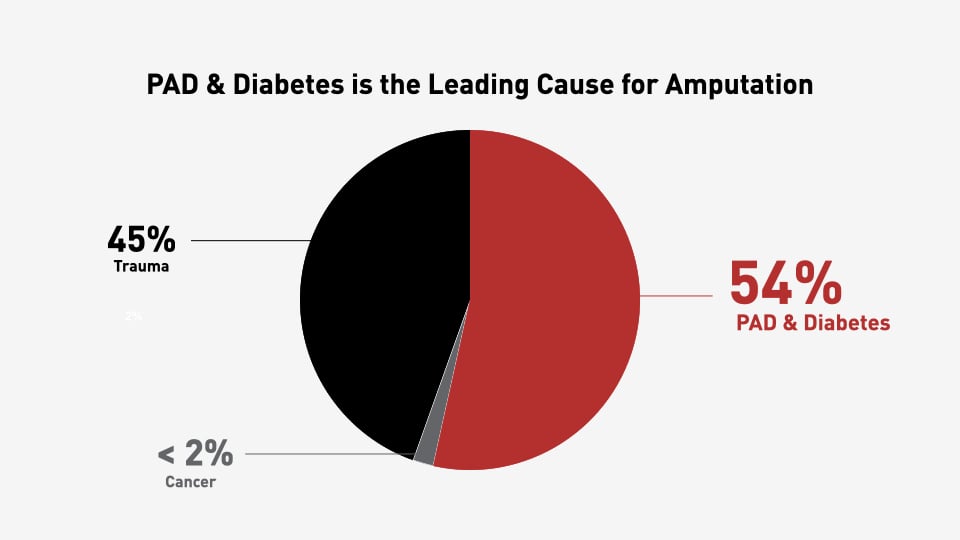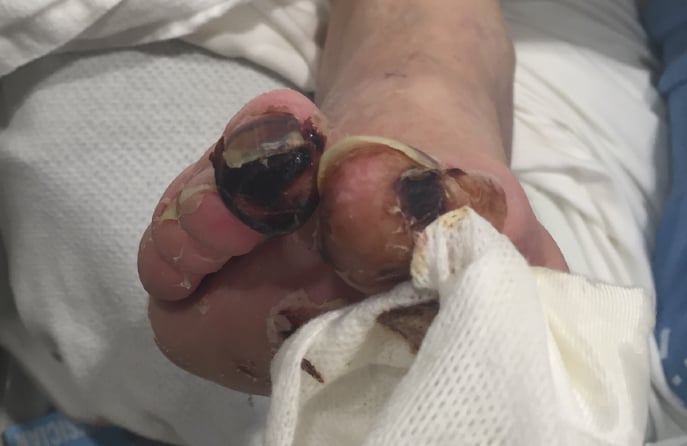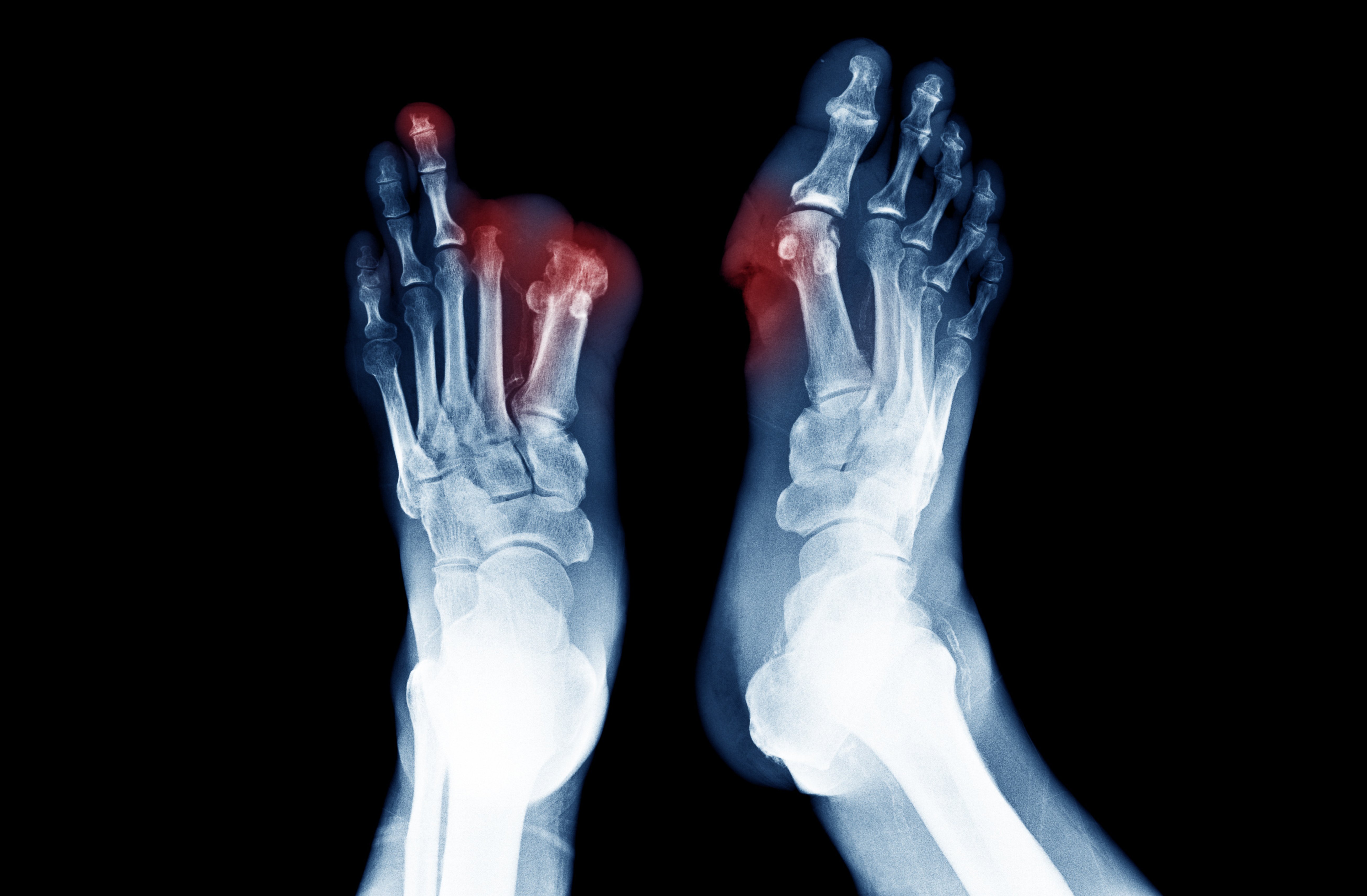Topics: Amputation

Many people are aware of amputation, but few know the medical definition of an amputation. Keep reading to learn more about the definition of amputation, its drawbacks and to understand how an atherectomy can prevent amputation.
In this article you’ll learn:
- What is the definition of an amputation
- What are the causes of amputation
- Why you should get a second option before amputation
- What procedure is available to restore blood flow and save a limb
What is Medical Definition of an Amputation?
Medically speaking, amputation is defined as when a patient’s extremity or limb such as a toe, foot or leg is partially or completely removed.
Most amputations require a hospital stay ranging from 5 to 14 days. However, this range can change based on factors such as the surgery itself and complications from amputation. Nearly 2 million people living in the U.S. are living with limb loss due to amputation, so it is important to understand what amputation truly means.1
What Are the Causes for Amputation?
There are numerous reasons that a patient may require amputation. However, the most common cause by far is poor circulation as a complication from diabetes and Peripheral Artery Disease (PAD). PAD results in poor circulation from blocked and narrowed arteries leading to patient’s extremities that prevent healthy blood flow. Eventually, the lack of blood flow can cause symptoms such as ulcers that will not heal and gangrene. These symptoms of Peripheral Artery Disease can get so severe if not treated that a patient requires limb amputation.

Additional causes for amputation include a traumatic injury and rare are cancer related amputations.
The Drawbacks of Amputation
Although an amputation may be a last resort for some patients, many patients are not aware that there are other options available. Some of the drawbacks associated with amputation include the financial burden it places not only on the patient, but on the medical system as a whole. For example, in 2009, hospital costs associated with amputation totaled more than $8.3 billion.2 This number is even more staggering when you consider that 185,000 amputations occur in the United States each year.3 This means that, on average, each amputation comes with hospital costs around $44,000. In addition to the original cost of the amputation, patients who have had a limb amputation pay $55,700 in annual health care costs.4
Other poor outcomes associated with amputation include shorter survival rates, loss of independence and higher levels of depression. In addition, the rate of death after a major amputation in the United States is approximately 48% after 1 year and 71% after 3 years.5 Amputations are so severe that patients with diabetic foot disease actually fear having a major lower-extremity amputation more than they fear death.6
All of these reasons explain why it is so important for patients to always get a second opinion, to see if there is an alternative solution to amputation. For example, many patients with diabetes, Critical Limb Ischemia and Peripheral Artery Disease (PAD) are never informed about an atherectomy as an option to save their limb.
Get a 2nd Opinion Before Amputation
Dr. Jaafer Golzar, a cardiologist who specializes in limb salvage believes that, “there's a lot of needless amputations that still go on today. If you or your loved one is faced with an amputation – without even attempting to revascularize (opening up the blood vessel), stop and get a second opinion.”
“there's a lot of needless amputations that still go on today. If you or your loved one is faced with an amputation – without even attempting to revascularize (opening up the blood vessel), stop and get a second opinion.”
- Dr. Jaafer Golzar
One option for restoring blood flow and preventing amputations is a Lumivascular Pantheris atherectomy. An atherectomy is a medical procedure where plaque is removed from the inside of an artery. Sadly, many patients with diabetes that have symptoms of Peripheral Artery Disease and Critical Limb Ischemia may have amputation presented as their only option to reduce the complications stemming poor circulation problems.
An atherectomy can help patients prevent ever needing amputation surgery. If a patient is diagnosed with PAD and it is crucial that they improve their symptoms so they will not need limb amputation due to poor circulation and gangrene. A Lumivascular Pantheris atherectomy is a proactive measure that can save lives and limbs. Because of the latest technological advancement in atherectomy therapy, the Lumivascular Pantheris procedure allows a doctor to see inside the patients’ artery in real time.
This advancement is achieved through a camera-like imaging fiber attached to the end of the catheter that goes through the patient’s arteries. Throughout the Lumivascular Pantheris atherectomy, a physician can clearly see inside the blocked artery and can distinguish between a patient’s healthy and diseased tissue. This means that physician will be able to remove as much plaque as needed in order to return a healthy blood flow through the artery. Many patients greatly benefit from restoration of flow, which is required for wound healing and limb salvage to occur.7 This healthy blood flow will ultimately improve the circulation of the limb and prevent any need for limb or extremity amputation.
If you are diagnosed with diabetes and Peripheral Artery Disease (PAD) and you do not want to risk amputation, make sure that you are proactive and ask a physician if a Lumivascular Pantheris atherectomy is a treatment option for you. Click here to find a Lumivascular atherectomy physician nearest you.
Take Action:
- Patient Story: Watch how Chuck Lyon prevented getting an amputation
- Learn more about Lumivascular atherectomy
- Find a Lumivascular doctor in your area
Related Articles:
References:
- Ziegler‐Graham, et al. Estimating the Prevalence of Limb Loss in the United States: 2005 to 2050. Archives of Physical Medicine and Rehabilitation2008;89(3):422‐9
- HCUP Nationwide Inpatient Sample (NIS). Healthcare Cost and Utilization Project (HCUP). Rockville, MD: Agency for Healthcare Research and Quality; 2009.
- Owings M, Kozak LJ, National Center for Health S. Ambulatory and Inpatient Procedures in the United States, 1996. Hyattsville, Md.: U.S. Dept. of Health and Human Services, Centers for Disease Control and Prevention, National Center for Health Statistics; 1998.
- Mustapha, et al. Determinants of Long‐Term Outcomes and Costs in the Management of Critical Limb Ischemia: A Population‐Based Cohort Study. J Am Heart Assoc. 2018 Aug 21;7(16)
- Swaminathan, et al. Lower extremity amputation in peripheral artery disease: improving patient outcomes. Vasc Health Risk Manag. 2014; 10: 417–424.
- Wukich, et al. Patients With Diabetic Foot Disease Fear Major Lower-Extremity Amputation More Than Death. Foot Ankle Spec. 2018 Feb;11(1):17-21.
- Varu, et al. Critical Limb Ischemia. J Vasc Surg. 2010 Jan;51(1):230-41.







